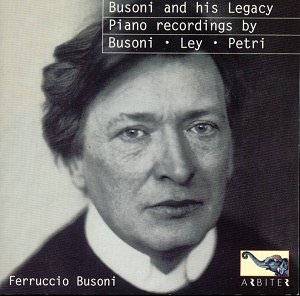Busoni was famously contemptuous of the recording
process and his anguished letters on the subject at the time are
reprinted here ("tiredÖillÖunprepared!"). In total only
four English Columbias were published and all are collated here
along with very rare recordings by Busoniís greatest pupil, Egon
Petri, and by a much less well-known musician, his English pupil
Rosamond Ley who left no commercial discs behind. Busoniís recorded
pianism has occasioned considerable, frequently negative, comment
over the years and has occasionally disconcerted even his greatest
admirers in its neutrality towards the romantic repertoire. In
all Busoni bequeathed less than half an hourís recorded music
making to posterity. Itís known that he made discs of others works,
the hyphenated Mozart-Busoni Andantino, Gounod-Liszt Faust Waltz,
Lisztís Petrarch Sonnet, the Paganini-Liszt Etude No. 5, Valse
Oubliée and Weberís Perpetuum Mobile, but these were all
rejected for publication.
The Bach C major Prelude and Fugue from Book
I of the Well Tempered Clavier allows one to hear Busoniís extraordinary
tonal beauty but along with it some extreme rubati and unexpected
accelerandi and decrescendos. He subjects the Prelude in particular
to some real metrical extension. The Bach-Busoni Chorale Prelude
sounds, indeed is, rushed but itís gloriously fluent and clearly
articulated nevertheless. Coupled with this on Columbia L1470
was the Ecossaise known as the Scotch Step and as with its discmate
itís full of verve and wit. When it comes to Chopin things are
highly personalised and problematic. The G flat Etude is crisp
and impressive but the F sharp Nocturne makes little effect other
than one of blank neutrality. The E minor Etude is rather mauled
through excessive rubato. In the main his Chopin can be disappointing,
mirroring perhaps something of his own ambiguity about the composer.
His Liszt, the sole surviving Liszt, is the Hungarian Rhapsody
in A minor and itís a magnificent performance, powerful and incisive,
and one that makes one regret anew the lack of those unpublished
Liszt sides.
His legacy was cemented by Petri, pupil and assistant
Ė hence the title of the CD. He is represented by the earliest
surviving off-air survivals of his art, Frankfurt performances
dating from 1932 and 1936. The sound, given the precarious nature
of the discs, which were taken by the Soviets as artistic war
booty at the end of the War, is in pretty good shape. The performances
are necessarily incomplete but pay testament to Petriís utter
identification with and absorption of Busoniís idiom in the movement
from the Piano Concerto. They also reveal him in the Totentanz
extract to be, as his reputation suggests, one of the centuryís
great Lisztians. The extract is in fact almost complete and derives
from a concert in which Petri and Rosbaud coupled the Busoni Concerto.
The Fourth Movement of the Concerto presented by Arbiter is not
from this concert but actually derives from a much earlier concert
in 1932, the only movement they performed on that occasion. The
Liszt is fast and fiery and daemonic and as Allan Evans eloquently
notes in the documentation the Busoni is technically, virtuosically
engaged to a remarkable degree.
Busoniís legacy also encompasses Rosamond Ley,
born in 1882 and a pupil of Oscar Beringer at the Royal Academy
of Music. She made her debut in 1905 and studied briefly with
Busoni in 1908. She later translated Busoniís letters to his wife
and helped organise two concert performances of Doktor Faust in
London. She died in 1969. In 1942 she went to private recording
studios in London, returning the following year, to set down her
only aural testament. She had long since given up a public career
Ė in fact her career as a recitalist seems to have trailed off
in the mid-1920s Ė but enough remains to show that she had been
a formidable pianist in the first two decades of the century.
Thereís some inevitable acetate scuffing but her Liszt Jeux díeau
à la Villa díEste is reasonably well played and the Dante
Sonata rather more than that Ė clarity and drive showing her mechanism
in good condition. Inevitably perhaps the recording canít quite
cope with some forte passages.
The Busoni recordings were last on Pearl Gemm
CD 9347 where they were coupled with a number of Petriís Busoni
recordings, some with Mitropoulos conducting the Minneapolis Symphony.
Arbiter employs what they call sonic depth technology in their
restoration. Pearlís transfer was much less interventionist retaining
more surface noise, maybe also more high frequency sound Ė but
Arbiter are to be congratulated on their very listenable transfers
and the intriguing couplings they provide.
Jonathan Woolf

